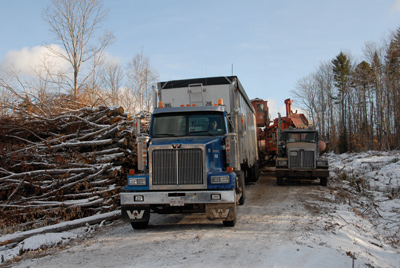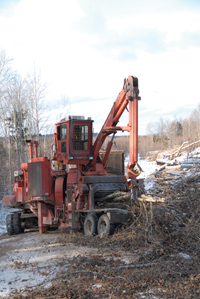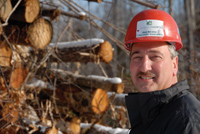
Big-volume Producer
June 14, 2010
By Bill Tice
Biomass is often associated with new and innovative sources of fuel for power generation, but at Acadian Timber, it has been a big part of the company’s business for over two decades.
Biomass is often associated with new and innovative sources of fuel for power generation, but at Acadian Timber, it has been a big part of the company’s business for over two decades.
 |
|
| Harvesting details are planned ahead so that residue chipping and trucking is as efficient as possible.
|
“We actually started delivering biomass through a slash recovery program back in 1989,” explains Normand Haché from his office in Plaster Rock, New Brunswick. Haché is a registered professional forester and a superintendent for Acadian, which handles all aspects of forest management, from growing seedlings to harvesting and delivering logs and wood fibre. “That first project was for a company in Maine that was looking for a secure supply of biomass,” he adds. “They were located just over 70 kilometres from our base here in New Brunswick, and the contract provided us with a steady stream of local business. It turned out to be a great market for a previously unused product.”
At that time, Haché and his fellow employees were the woodlands group of Fraser Papers and they handled all of the lumber and pulp and paper company’s forestry and fibre supply activities. Following the success of the Maine project, they added to their biomass repertoire in the mid-1990s when Fraser Papers installed a 45-MW biomass-fired power plant of its own at its pulp and paper mill in Edmundston, New Brunswick. From that point on they never really looked back, says Haché.
Becoming Acadian
Things did change for Haché and the rest of the staff and crew of the Fraser Papers’ Woodlands Group in January of 2006 when they became part of Brookfield Asset Management Inc., a global asset manager focused on property, renewable power, and infrastructure assets. Brookfield, which has more than $100 billion of assets under its management, now controls over 50% of Acadian Timber Corp. and also holds a controlling interest in Longview Timber, Fraser Papers, and British Columbia’s Island Timberlands. Despite the ownership change and name change to Acadian Timber, Haché says that their mandate remained relatively unchanged and they continued to deliver logs and other fibre, including biomass, to over 100 customers, primarily in New Brunswick, Maine, and Quebec.
Today, Acadian Timber works in many areas of New Brunswick and Maine. The company is one of the largest timberland operators in the region and owns almost 450,000 hectares (1.1 million acres) of private land, 92% of which is productive forestland. “We own 310,000 hectares (765,000 acres) here in New Brunswick and another 126,000 hectares (311,000 acres) across the border in Maine,” explains Haché. “We also manage 532,000 hectares (1.3 million acres) of New Brunswick Crown land,” he adds.
Incorporating Biomass
Biomass fits well with Acadian Timber’s business model, as the company can incorporate biomass production into its day-to-day and long-term planning and operations. Haché says it “just makes sense,” as with a little extra work during the block planning and harvesting processes, they can use almost 100% of the timber on a block. It creates synergies for everyone involved.
 |
|
| Boyd B. Harding, Acadian Timber’s biggest contractor, runs a fleet of four Morbark whole-tree chippers to process the biomass left over from harvesting.
|
“Basically, our management plan forms the basis of everything we do,” he explains. “We plan at least one year out and we know where we are going and what we will be doing. When we get to the block and start working, the delimber operator makes the decisions. He decides if a log is sawmill quality, a peeler for plywood, a pulp log, or biomass. He separates the logs into the different sorts, and when he delimbs and bucks the logs, he makes a separate pile for the tops and branches, as they will go into the slash recovery program.”
Most of the logging and biomass production for Acadian is done by contract crews and is handled with a combination of feller bunchers and grapple skidders. “That’s the process for 85% of the blocks we harvest,” Haché explains. “About 10% is done with processors and porters (forwarders), while the balance is hand felled and then transported with a TLD Gauthier carriage system out of Saint-Gilbert, Quebec. This cable system is mainly used in buffer zones.”
In total, Haché says, Acadian works with nine logging contractors, but only four of the contractors handle biomass. Two of those four will do both biomass and more traditional harvesting. Between Acadian’s own timberlands in New Brunswick and in Maine, the company has a “long-run sustainable yield” of 928,000 cubic metres/year – 651,000 cubic metres on the Canadian side of the border and 277,000 on the U.S. side. They also have an annual allowable cut on the New Brunswick Crown land of 1.1 million cubic metres, of which 650,000 cubic metres is harvested by sub-licensees and the balance is handled directly by Acadian Timber. In terms of biomass, Haché says they have averaged about 350,000 tonnes of biomass annually over the past five years, making the company one of the largest biomass suppliers in the region.
Biggest Contractor
Acadian’s largest logging and biomass contractor is Boyd B. Harding, a homegrown logging and transportation company from Plaster Rock. “We handle logging, chipping, and trucking for Acadian’s traditional logging side and their biomass business,” says Darren Burgoyne, trucking supervisor and senior manager at Boyd B. Harding, which has been in business for around 35 years. Today, the company employs in excess of 80 people year round and runs seven crews on a regular basis – three for handling logs that will go to sawmills, panel mills, and pulp mills, and four for biomass harvesting and processing. Burgoyne, who grew up in Plaster Rock and has been with the company for 23 years, says that Acadian Timber is by far their largest customer, adding that they typically harvest about 200,000 cubic metres of roundwood annually for Acadian and last year processed close to 240,000 tonnes of biomass for the company.
 |
|
| Normand Haché, superintendent for Acadian Timber, says that biomass fits well with the company’s business model.
|
In terms of equipment, Boyd B. Harding runs a fairly substantial fleet of gear, including four Morbark 30-inch whole-tree chippers, a Tigercat 822 and two Tigercat 860 feller bunchers, four Caterpillar 322 machines all equipped with Denharco delimbing heads, and 16 skidders – one is a Tigercat E620C and the balance of the skidders are Cat 524, 535, and 545 models. “We have two skidders working with every delimber, and each site has at least one spare skidder in case of breakdowns,” Burgoyne explains. “That way, we can keep our productivity up.”
Log loading is all contracted out. For biomass, the company’s Morbark chippers feed straight into waiting chip vans. Each of the chippers has its own dedicated Caterpillar skidder for moving materials to within reach of the chipper’s grapple.
On the biomass side, Burgoyne says they have worked with Acadian since day one, back in 1989, and have developed a system that really works for them in terms of efficiency and productivity. “We take a good look at how far out the chippers are working and we know the turnaround times for the trucks from the bush to the delivery point, so we basically just make sure we have enough trucks arriving at each block at the right times,” he explains. “We don’t want a truck sitting in the bush waiting and we don’t want the chipper to have to shut down because he has nowhere to put the chips. Our goal is at least 10 loads/day from each chipping site and, in many cases, we will do more.”
Tricks of the Trade
Burgoyne says that they have developed a few tricks over the years to help the crews meet maximum productivity when it comes to biomass production. “It’s just little things,” he notes. “For example, in the winter we change the angle of the knives in the chippers, which makes them last longer between knife changes. We also position the equipment on angles so that we can minimize moving; we always work from the right-hand side when we are coming out of the bush so that production flows; and we make sure our branches are piled neatly, which minimizes tangling. If we can save just a few seconds on each grapple load being put into the chipper, it adds up to a huge amount of time and a big increase in productivity over the course of a day. We target one load of biomass in the truck every 30 minutes.”
Safety is of course a big concern, and Burgoyne says they have developed a homemade system for safely and efficiently dealing with one issue many biomass producers face – Y-shaped trees. “We have welded a piece of steel on to the side of every chipper we own, and if the operator gets a Y-shaped tree, he just slides the Y under the steel and it breaks off as he pulls the tree through. He doesn’t need to get out of the cab with his power saw, which is not only safer, it’s quicker.”
Trucking Challenges
One major challenge Burgoyne says that they must deal with is trucking weights, especially when they cross the border into Maine. “They can bar you from entering the United States if you are overweight,” he explains. “We have gone with lightweight trailers from Manic Trailers in Quebec, and all of our trucks are equipped with air ride and gauges that provide the drivers a pretty good idea of where they are at.”
Burgoyne knows the trucking business well. He was a driver for five years with Boyd B. Harding before moving into management, and the company owns Tobique Western Star, which is the truck manufacturer’s dealer in northwest New Brunswick. They have also gone “high tech” by equipping each truck, including the chip trucks, with a global positioning system (GPS) that records speed, downtime, and travel routes. “We call it ‘the black box’, and it provides me with a printout every Monday that shows exactly what each truck did for the previous week,” says Burgoyne. “If I see on the printout that a truck sat in the woods for an hour and a half, I can start asking why, and even in terms of speed, the trail the truck covered will turn a different colour if they exceeded the speed limit. Shadow Tracker manufactures the units and our cost was about $700 per truck. It was another $1500 for the base unit, but in my opinion, the payback was quick and it was worth the investment.”
For Acadian Timber, biomass has become a mainstay of its business, and contractors such as Boyd B. Harding keep the fibre flowing. Acadian’s Haché sums it up nicely. “Developing and building the biomass business has been great for us, our customers, and for our contractors,” he says. “We are able to take a product that would have been burned in the bush 25 years ago and turn it into a viable and profitable business that is good for everyone’s bottom line and the environment, as it allows us to use almost 100% of the fibre we harvest.”
Print this page